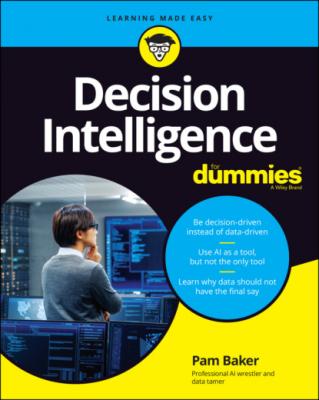Decision Intelligence For Dummies. Pamela Baker
Читать онлайн.| Название | Decision Intelligence For Dummies |
|---|---|
| Автор произведения | Pamela Baker |
| Жанр | Базы данных |
| Серия | |
| Издательство | Базы данных |
| Год выпуска | 0 |
| isbn | 9781119824862 |
Evaluating man-versus-machine in decision-making
Business leaders often formulate a vision for their company or a particular project. This practice is not an attempt to predict the future but rather to aim for a specific future. This person is steering toward a future that they believe to be profitable or advantageous to the company. A vision, then, is a decision with a purpose.
How do you form a business vision? Developing an obtainable vision requires both creative and deductive skills. A business leader must be able to imagine possibilities, recognize opportunities, deduce their value and the probability of success, and shape a new or creative idea — a vision, in other words.
In short, a leader’s vision is part imagination and part information with more than a dash of math. Business acumen is a talent based in large part on pattern recognition and the ability to see connections between heretofore unrelated items or pieces of information.
Given that data analytics and machine learning are particularly adept at discovering patterns and data relationships, why are they not good at identifying new business visions? Part of an answer might be found in W.I.B. Beveridge’s The Art of Scientific Investigation, where the author explores the intuitive side of scientists and speaks of originality as “often consisting in linking up ideas whose connection was not previously suspected.” Interestingly, that book was originally published way back in 1950 by W.W. Norton & Company Inc. Other great visionaries explain the role of imagination expressed in any form — whether it’s art, science, or business — in similar terms. For example, the legendary graphical designer Paul Rand said that the role of the imagination “is to create new meanings and to discover connections that, even if obvious, seem to escape detection.”
What about logic and math and the other hard skills that machines do excel in? Do they not form the lion’s share in importance and worth when it comes to making a decision — particularly in data driven companies? It’s true that machines do surpass human skills in this regard. Machines can do math faster and usually error-free, but humans can do it without even consciously thinking about it.
The human brain runs a significant part of this work in the background, leading to the seemingly out-of-nowhere “Eureka!” moment in a flash of inspiration. It’s called intuitive intelligence — the ability to use the subconscious mind to make faster and more integrated decisions.
Though both human and machine have pros and cons when it comes to decision-making, leveraging the strengths of each leads to decisions that consistently deliver a better value to the organization. This is why disregarding or discounting human instinct, gut feelings, experience, and talent is a grave error — just as overinflating the value of data and machines can easily lead you down the wrong path. Decision intelligence, acting as a multidisciplinary approach to creating balance between person and machine, is in a position to deliver targeted decisions for predetermined business outcomes that move an organization forward.
Конец ознакомительного фрагмента.
Текст предоставлен ООО «ЛитРес».
Прочитайте эту книгу целиком, купив полную легальную версию на ЛитРес.
Безопасно оплатить книгу можно банковской картой Visa, MasterCard, Maestro, со счета мобильного телефона, с платежного терминала, в салоне МТС или Связной, через PayPal, WebMoney, Яндекс.Деньги, QIWI Кошелек, бонусными картами или другим удобным Вам способом.
